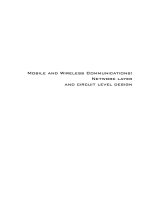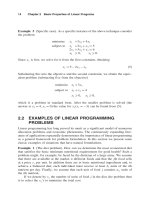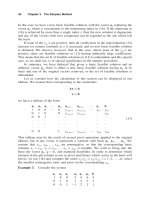linear circuit 1 experiment manuals
Bạn đang xem bản rút gọn của tài liệu. Xem và tải ngay bản đầy đủ của tài liệu tại đây (1.39 MB, 35 trang )
<span class="text_page_counter">Trang 1</span><div class="page_container" data-page="1">
1
LINEAR CIRCUIT 1 Experiment Manuals
Version: 2022, Jan, 29 Edited by Tran Thi Thao
Recommended and Approved by Cung Thanh Long
Contents
Lab #1: Kirchhoff's Current and Voltage Laws ... 2
Lab #2: Nodal Analysis ... 7
Lab #3: Loop Analysis ... 10
Lab #4: Thévenin and Norton Equivalent Circuits... 13
Lab #5: Power Relationships ... 18
Lab #6: Superposition ... 22
Lab #7: First Order Circuits ... 25
Lab #8: Second Order Circuits ... 30
</div><span class="text_page_counter">Trang 2</span><div class="page_container" data-page="2">• Compare experimental results with those using hand calculations
II. BACKGROUND & THEORY 1. Kirrchhoff’s Current Law
Kirchhoff’s Current Law (KCL) states that the algebraic sum of currents leaving any node or the algebraic sum of currents entering any node is zero. KCL can be stated as the sum of the currents entering a node must equal the sum of the currents leaving a node.
Kirchhoff’s Current Law can also be expressed as follows.
(a) The algebraic sum of the currents entering a junction (node) equal zero. (b) The algebraic sum of the currents leaving a junction (node) equal zero.
(c) The algebraic sum of currents entering a node equal to the algebraic sum of currents leaving a node.
Consider the node shown in Figure 1
Figure 1. A node illustrating Kirchhoff's current law
</div><span class="text_page_counter">Trang 3</span><div class="page_container" data-page="3">2. Kirrchhoff’s Voltage Law
Kirchhoff's Voltage Law (KVL) states that the algebraic sum of voltages around a closed path is zero. As you make a summation of voltages, it is suggested that you proceed around the closed path in a clockwise direction. If you encounter a positive (+) sign as you first enter the circuit element, then add the value of that. On the contrary, if you first encounter a negative sign as you enter the circuit element, then subtract the value of that voltage.
We can state Kirchhoff’s Voltage Law in three ways which all really say the same thing: • The algebraic sum of the voltage drops around any closed path of an electric circuit equal zero. • The algebraic sum of the voltage rises around any closed path of an electric circuit equal zero. • The algebraic sum of the voltage rises equal the algebraic sum of the voltage drops around any closed path of an electric circuit.
Consider the circuit of Figure 2.
</div><span class="text_page_counter">Trang 4</span><div class="page_container" data-page="4">4
Figure 2. Circuit for illustrating Kirchhoff's voltage law
Starting at the lower left-hand corner, going clockwise, using voltage drops we have: -V<small>s1</small>+ V V<small>A </small>– <small>B</small> +V<small>s2</small>+V<small>C </small>- V<small>D</small>=0
Starting at the lower left-hand corner, going clockwise, using voltage rises we write: V<small>s1</small>- V<small>A </small>+ V V V<small>B</small> - <small>s2</small>- <small>C </small>+V<small>D</small>=0
The second equation is simply the first one multiplied through by -1 and therefore really the same equation. If we assume a clockwise reference current through all the elements (Figure 3) in the circuit we can use Ohm's law to write:
V<small>A</small>=R<small>1</small>I, V =-R I, V<small>B2C</small>=R<small>4</small>I, V =-R<small>D3</small>I, Then, substituting these equations into the previous KVL equation,
-V<small>s1</small>+ R I -R I<small>1 </small>–( <small>2</small>) +V<small>s2</small>+ V R I<small>C 4 </small>– (R I<small>3</small>) =0 or (R<small>1+</small> R<small>2</small> +R<small>3</small>+ R<small>4</small>)I= V<small>s1</small>+ V<small>s2</small>
Figure 3. Circuit for illustrating KVL example III. EQUIPMENT AND PARTS LIST
• Digital Multimeter (DMM) • DC power supply • Circuit bread board • Resistors IV. PROCEDURE
Consider the circuit shown in Figure 4
</div><span class="text_page_counter">Trang 5</span><div class="page_container" data-page="5">5
Figure 4 Circuit for Voltage and Current Measurements
1. Without substituting in numbers for R , R , R , and R apply Kirchhoff's Current Law at nodes <small>1234</small>1 and 2 so as to obtain two equations in terms of the two unknown node voltages V and V<small>12</small>. Simplify these equations.
2. Let R = 2k , R = 4.7k , R = 1k , and R = 3.3k in the equations of Step 1. <small>1234</small>Solve these equations by hand for V and V . <small>12</small>
From V and V , find Va,Vb,Vc, Ia, Ib, and Ic. <small>12</small>
3. Measure the resistors. Use these values to find V ,V , Va, Vb,Vc, Ia, Ib, and Ic as in Step 2. <small>12</small>4. Construct the circuit shown in Figure 4.
5. Use the multimeter to measure the indicated three currents and five voltages.
6. Compare the results of Step 2 with those obtained from the theoretical calculations of Steps 2 and 3 above.
7. Using the measured values of the three currents, check KCL at node 2.
8. Use your measured values of the source voltage, Va, Vb, and Vc to check Kirchhoff's Voltage Law for the outer loop of the circuit.
V. CALCULATIONS AND COMPARISONS
1. Use your measured current values to determine if KCL is verified to within the limits of the measuring equipment. Also use Ohm's Law and nominal resistance values to calculate Ia, Ib, and Ic. Repeat the calculations using the measured resistance values. Make a chart to compare measured current values with the two sets of calculated values. Include the % differences in this
12 volts
</div><span class="text_page_counter">Trang 6</span><div class="page_container" data-page="6">6
chart. Are the differences between the measured values and the values calculated using the measured resistance values within the accuracy limits of the DMM? Are the differences found using the nominal values for calculations within the tolerance limits of the resistors?
2. Use your measured voltage values to determine if KVL is verified to within the limits of the measuring equipment. Also use measured value of I , measured values of resistance, and Ohm's <small>c</small>Law to calculate V , V , and V . Make a chart to compare these calculated voltage values with <small>abc</small>the measured voltage values. Are all differences within the expected limits of accuracy? VI. CONCLUSIONS
Based on the results from the experiments.
</div><span class="text_page_counter">Trang 7</span><div class="page_container" data-page="7">7
Lab #2: Nodal Analysis
I. OBJECTIVES
• To learn and apply Nodal Analysis
• To obtain further practice in electrical measurements
• Compare experimental results with those using hand calculations
II. BACKGROUND & THEORY
Analysis of electrical networks involves determination of node voltages and loop or branch currents. Nodal Analysis refers to the technique of writing equations where the unknown quantities are the node voltages of the circuit. Kirchhoff's current law is used to define the equations at each node in the circuit, using currents obtained by Ohm's law.
III. EQUIPMENT AND PARTS LIST
• Digital Multimeter (DMM) • DC power supply • Circuit bread board • Resistors IV. PROCEDURE Experiment 1:
1. Consider the circuit shown in Figure 1
2. Measure (with the multimeter) and record the resistance of each resistor you use. Use the multimeter to adjust the power supply.
3. Measure and record all node voltages and branch currents. 4. Construct the circuit of Figure 1.
5. Measure (with the multimeter) and record the resistance of each resistor you use. 6. Measure and record all node voltages and branch currents.
</div><span class="text_page_counter">Trang 8</span><div class="page_container" data-page="8">Figure 2. Circuit for nodal analysis in Experiment 2
The bridge circuit can be used to determine the value of an unknown resistor if several known resistors are available. For example, if the R leg was an unknown resistor we could use various <small>3</small>combinations of known resistors for the R , R , and R legs until the balance condition was <small>124</small>achieved. We would then know that R = R<small>34</small>·(R<small>1</small>/R<small>2</small>).
2. Using the resistance and voltages given in Figure 2, determine all node voltages and branch currents in the circuit. Using the voltage and current values, calculate the power dissipated by each resistor.
1k 1k
2k 12 volts
</div><span class="text_page_counter">Trang 9</span><div class="page_container" data-page="9">9
3. Determine a new value for R , leaving the other resistors unchanged, that will balance the <small>4</small>bridge circuit. Assume an adjustable resistor is used so that any resistance value can be obtained. 4. Construct the circuit shown in Figure 2.
Measure and record the resistance of each resistor you use. 5. Use the multimeter to adjust the power supply.
6. Measure and record all node voltages and branch currents V. CONCLUSIONS
Based on the results from the experiments.
</div><span class="text_page_counter">Trang 10</span><div class="page_container" data-page="10">10
Lab #3: Loop Analysis
I. OBJECTIVES
• To learn and apply Loop Analysis
• To obtain further practice in electrical measurements
• Compare experimental results with those using hand calculations.
II. BACKGROUND & THEORY
Circuit equations involving Kirchhoff's current law (KCL) are used in nodal analysis to determine the unknown node voltages. In loop analysis, on the other hand, the unknown quantities are loop currents, and the circuit equations are written using Kirchhoff's voltage law (KVL).
begin the loop analysis procedure each loop of the network is assigned an unknown current. ToThe direction chosen for the current in the loop is arbitrary: the calculated current will turn out to be negative if the actual current flows in the direction opposite to the one chosen for the analysis. The loop equations are written by applying KVL to each loop: the sum of the voltages around each loop must be zero. In any resistors shared by adjacent loops the net current in the component consists of the sum or difference of the two loop currents, depending on whether the two currents are defined low in the same or different directions. Once the set of current equations is solved the calculated loop currents can be used to determine the voltage across each of the resistances using Ohm's law.
III. EQUIPMENT AND PARTS LIST
• Digital Multimeter (DMM) • DC power supply • Circuit bread board • Resistors IV. PROCEDURE Experiment 1:
1. Consider the circuit shown in Figure 1
2. Use loop analysis to determine the loop currents and branch currents for the circuit of Figure 1 using hand calculator (pre-lab). Also calculate the resistor voltage and the power dissipation for each resistor. Verify your results using a symbolic mathematics computer program such as Matlab.
</div><span class="text_page_counter">Trang 11</span><div class="page_container" data-page="11">11
Figure 1. Circuit for loop analysis in Experiment 1 3. Measure and record all node voltages and branch currents. 4. Assemble the circuit of Figure 1 using the specified resistors.
5. Adjust the power supply for 12 volts. Measure the current in each branch of the circuit, i.e., the current in R & R , in R , and in R & R . <small>12345</small>
6. Now replace R <small>5</small>with two 330Ω resistors in parallel and re-measure the current in each branch of the circuit. Next, replace R<small>5</small> with three 330Ω resistors in parallel and measure the branch currents again. Be sure to measure and record the actual resistance of the nominal 330Ω resistors use.
7. Measure and record all node voltages and branch currents. Experiment 2:
1. Consider the circuit shown in Figure 2.
2. Determine all loop currents and branch currents for the circuit of Figure 2. Note that the circuit is the same as Figure 1 except resistor R <small>6</small>= 1kΩ has been added to the circuit.
3. Measure the current supplied by the voltage source? What is the power supplied by the voltage source?
R<small>1</small>=10 ; R =100<small>2</small> ; R<small>3</small>=100 ;R =1k<small>4</small> ; R<small>5</small>=330 ;V=12 volts
</div><span class="text_page_counter">Trang 13</span><div class="page_container" data-page="13">• To build a Thévenin equivalent of the original circuit and check to see if it really is equivalent
II. BACKGROUND & THEORY
2.1.Thévenin's theorem
Thévenin's theorem states that any two-terminal circuit with linear elements can be represented with an equivalent circuit containing a single voltage source in series with a single resistor. The Thévenin equivalent circuit is shown in Figure 1.
Figure 1. A two-terminal circuit consisting of resistances and sources can be replaced by a Thévenin equivalent circuit
The equivalent circuit consists of an independent voltage source v<small>oc</small> and a series resistor . The R<small>t</small>resistor is determined by removing all independent sources (short voltage sources and open R<small>t</small>current sources). v<small>oc</small> is found by measuring the open circuit voltage across the output and is i<small>sc</small>found by measuring the current between the shorted output connections.
and are computed as follows: v<small>oc</small> R<small>t</small>
Thévenin equivalent
</div><span class="text_page_counter">Trang 14</span><div class="page_container" data-page="14">14
Figure 2. Thévenin equivalent circuit with short circuited terminals
Thévenin's and Norton circuits are equivalent and if one is known, the other is also easily determined. Actually, measuring the short circuit current in a real circuit is often not recommended (the circuit may not be designed to handle the high current) and may damage the circuit. Circuits with no independent sources require a different technique; a source must be connected to the output and the current or voltage measured.
2.2. Maximum Power Transfer
The load resistance that absorbs the maximum power from a two-terminal circuit is equal to the Thévenin resistance.
Figure 3. Circuits for analysis of maximum power transfer
The maximum voltage at the output of a linear source is
<small>sc</small>
</div><span class="text_page_counter">Trang 15</span><div class="page_container" data-page="15">15 The maximum current at the output of a linear source is
The maximum power delivered by a linear source to a matched load resistance R = R = R <small>LTn</small>is
III. EQUIPMENT AND PARTS LIST
• Digital Multimeter (DMM) • DC power supply • Circuit bread board • Resistors IV. PROCEDURE
4.1. Theoretical Calculations Experiment 1:
Figure 4. Circuit for Thevenin Equivalent Circuit Calculation for Experiment 1 1. Calculate the Thevenin equivalent circuit to the left of terminals x,y.
2. Use the circuit from Step 1 to find the expression for the power dissipated in the load R and <small>L</small>the expression for the voltage across the load resistor.
3. Let R vary between 0 and 20k . <small>L</small>V=24 volts
</div><span class="text_page_counter">Trang 16</span><div class="page_container" data-page="16">16 (a) Plot power dissipated in R versus R <small>LL</small>
(b) Plot the voltage across R versus R . In both plots show the point on the graph corresponding <small>LL</small>to the value of R that theoretically maximizes the load power. <small>L</small>
Note: the plots can be drawn using Matlab. Experiment 2:
(1) Find the Thevenin and Norton equivalent circuits for Figures 5a and 5b. With V= 12 volts, determine the power absorbed by the 100 Ω resistor if the output terminals were shorted (to determine i<small>sc</small>).
Figure 5. Circuits for Experiment 2
(2) Now with V= 24 volts, calculate the V for Figure 5a using 10% tolerance resistors. <small>th</small>(3) If V =5 V and R<small>octh</small>=275 Ω (circuit 5b), determine the power supply voltage of the original circuit and the value of R.
4.2. Laboratory Experiment Experiment 1:
1. Assemble the circuit in Figure 4 without R . <small>L</small>
Use combinations of resistors from your kit to make R while assembling the circuit. Measure <small>5</small>the voltage across the point’s xy. It is the open circuit voltage.
Short circuits the points x and y. Now, measure the current flowing in the short-circuited branch ‘xy’. This gives you the short circuit current.
Determine the Thevenin’s equivalent circuit from your measurements and compare with the theoretical data obtained earlier.
2. Remove the short circuit and place the resistor R<small>L</small> of value equal to the Thevinin’s resistance found by measurements.
</div><span class="text_page_counter">Trang 17</span><div class="page_container" data-page="17">4. Vary R in increments of 500 from 0 to 10k . For each value of R record the load voltage. <small>LL</small>Also record the load voltage at the theoretical value of R that maximizes the load power. For <small>L</small>each value of load voltage calculate the load power.
As R is varied, make sure to do the measurement for R equal to R . <small>LLth</small>
5. Modify the graphs from Theoretical Calculations, step 3 above by superimposing your experimental results onto the theoretical graphs.
Use the plot symbol "o" to denote the experimental voltage or power. Don't connect the experimental data points by connecting lines. End up with two graphs:
(a) Theoretical and experimental power versus R <small>L</small>
(b) Theoretical and experimental load voltage versus R over the range 0 < R < 20 k .<small>LL</small>Experiment 2:
1. Construct circuit 5a (using a 100 Ω resistor with large enough power rating to absorb i<small>sc</small>). Measure v and i at the output. Remember to measure the resistance of each resistor used. <small>ocsc</small> Now imagine that you are unable to measure i<small>sc</small> because a 100 Ω resistor with a large enough power rating is unavailable (or pretend the power supply might be damaged).
Take an additional measurement that will allow you to construct the Thevenin equivalent. 2. Place the following "loads" across the output and record voltage across and current through. (Use 100 Ω, 220 Ω, 330 Ω and 470 Ω)
V. CONCLUSIONS
Based on the results from the experiments.
</div>








